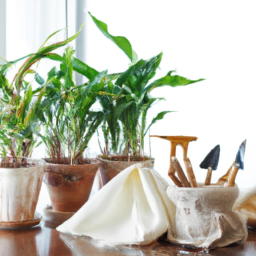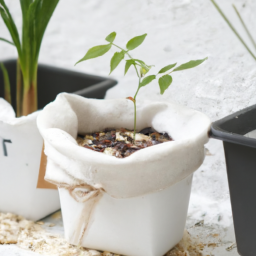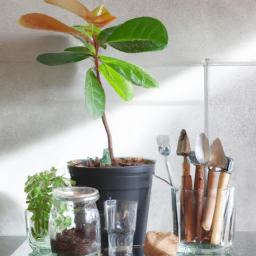
Are you a proud plant parent, wondering if you should be feeding your indoor plants? Well, you’ve come to the right place! In this blog post, we’ll dive into the topic of “Should I Feed Indoor Plants” and explore the importance of providing proper nutrients to keep your leafy companions thriving. Whether you’re a seasoned plant enthusiast or just starting your indoor gardening journey, understanding the nutritional needs of your plants is key to their overall health and longevity. So, let’s get started and find out if feeding your indoor plants is a must-do or a mere suggestion!
Benefits of Feeding Indoor Plants
Introduction
Indoor plants not only add beauty and freshness to our living spaces but also provide numerous benefits for our well-being. Just like outdoor plants, indoor plants require proper nutrition to thrive and maintain their health. In this article, we will explore the advantages of providing adequate nutrition to your indoor plants and why it is essential for their growth and longevity.
Improved Growth and Appearance
Feeding indoor plants with the right nutrients promotes their overall growth and enhances their appearance. Just like humans, plants need a balanced diet to stay healthy. Essential nutrients such as nitrogen, phosphorus, and potassium are crucial for their development. Nitrogen aids in leaf and stem growth, phosphorus stimulates root development, and potassium helps in overall plant health and disease resistance.
By providing these nutrients through proper feeding, you can ensure that your indoor plants grow vigorously, have lush foliage, and produce vibrant flowers. Well-nourished plants are more likely to resist pests and diseases, resulting in a healthier and more visually appealing indoor garden.
Moreover, indoor plants that receive adequate nutrition are less likely to suffer from nutrient deficiencies, which can lead to stunted growth, yellowing leaves, or other signs of poor health. By feeding your indoor plants, you are giving them the best chance to thrive and reach their full potential.
Enhanced Air Quality
One of the significant benefits of indoor plants is their ability to purify the air by removing harmful pollutants and releasing oxygen. Feeding indoor plants helps them maintain their efficiency in air purification. When plants are well-nourished, they can efficiently absorb and break down pollutants such as formaldehyde, benzene, and carbon monoxide.
By regularly feeding your indoor plants, you are ensuring that they have the necessary nutrients to carry out these air-purifying processes effectively. This, in turn, leads to improved air quality in your home or office, providing a healthier environment for you and your family.
Additionally, well-fed indoor plants release oxygen during photosynthesis, which can increase the oxygen levels in your indoor spaces. This can have a positive impact on your overall well-being, promoting better breathing and reducing the risk of respiratory problems.
Stress Reduction and Mental Well-being
Indoor plants have been proven to have a positive effect on our mental well-being by reducing stress and improving our mood. Feeding your indoor plants can contribute to their ability to provide these mental health benefits.
When plants are well-fed, they are more likely to thrive and display vibrant colors and healthy foliage. The sight of healthy plants can have a calming and soothing effect on our minds, reducing stress and anxiety. Taking care of indoor plants by feeding them also provides a sense of purpose and responsibility, which can be fulfilling and boost our overall mood.
Furthermore, the act of feeding indoor plants and tending to their needs can be a therapeutic and enjoyable activity. It allows us to connect with nature, even in indoor environments, and provides a sense of accomplishment as we witness the positive effects of our care and attention.
Conclusion
Feeding indoor plants is essential for their growth, appearance, and overall well-being. By providing them with the necessary nutrients, you are ensuring their optimal development, enhanced air quality, and mental health benefits. Remember to choose the right fertilizer and follow the recommended feeding schedule for each type of indoor plant. With proper nutrition, your indoor plants will thrive, bringing beauty, freshness, and numerous advantages to your living spaces.

Should I Feed Indoor Plants?
Indoor plants are a wonderful addition to any home or office space. They not only bring a touch of nature indoors but also provide numerous benefits such as improving air quality and reducing stress levels. However, to ensure their healthy growth and longevity, it is essential to provide them with proper nutrition. In this article, we will explore the nutritional requirements for indoor plants and help you understand the specific nutrients they need to thrive.
Understanding the Specific Nutrients Indoor Plants Need
Just like humans, plants require a balanced diet to stay healthy. While they can obtain some nutrients from the air and water, they often need additional supplementation to meet their nutritional needs. Let’s take a closer look at the specific nutrients indoor plants require:
1. Macronutrients: These are the primary nutrients that plants need in relatively large quantities. They include nitrogen (N), phosphorus (P), and potassium (K), often referred to as NPK. Nitrogen is essential for leaf and stem growth, phosphorus promotes root development and flowering, and potassium helps with overall plant health and disease resistance.
2. Micronutrients: While macronutrients are required in larger amounts, plants also need micronutrients, albeit in smaller quantities. These include iron (Fe), manganese (Mn), zinc (Zn), copper (Cu), boron (B), molybdenum (Mo), and chlorine (Cl). Micronutrients play vital roles in various plant functions, such as photosynthesis, enzyme activation, and hormone production.
3. Water: While water is not a nutrient per se, it is essential for plants’ survival. It helps transport nutrients throughout the plant, maintain turgidity, and facilitate various metabolic processes. Proper watering practices are crucial to ensure plants can absorb and utilize the nutrients they receive.
Providing Proper Nutrition to Indoor Plants
Now that we understand the specific nutrients indoor plants need, let’s discuss how to provide them with proper nutrition:
1. Choose the Right Potting Mix: Start by selecting a high-quality potting mix specifically formulated for indoor plants. These mixes often contain a balanced blend of organic matter, such as peat moss or compost, and provide essential nutrients to support plant growth.
2. Fertilize Regularly: While potting mixes may contain some nutrients, they can become depleted over time. Therefore, it is crucial to fertilize indoor plants regularly. Choose a well-balanced fertilizer with an NPK ratio suitable for your specific plant species. Follow the instructions on the fertilizer package for application rates and frequency.
3. Monitor Nutrient Deficiencies: Keep an eye out for signs of nutrient deficiencies in your indoor plants. Yellowing leaves, stunted growth, or poor flowering can indicate a lack of specific nutrients. If you notice any deficiencies, adjust your fertilization routine accordingly or consider using a specialized nutrient supplement.
4. Consider Organic Alternatives: If you prefer to use organic methods, there are several options available. Compost tea, worm castings, or seaweed extract can provide a natural source of nutrients for your indoor plants. Just ensure you follow the recommended application rates to avoid over-fertilization.
5. Water Wisely: Proper watering practices are crucial for nutrient uptake. Avoid overwatering, as it can lead to root rot and nutrient leaching. Allow the top inch of the potting mix to dry out before watering again. Use room temperature water and ensure proper drainage to prevent waterlogging.
6. Observe Plant Responses: Each indoor plant has its own unique requirements. Observe how your plants respond to different fertilizers and watering practices. Adjust your approach based on their specific needs, as some plants may require more frequent or diluted fertilization.
By following these steps and understanding the specific nutritional requirements of your indoor plants, you can ensure they receive the proper nutrition for healthy growth. Remember to monitor your plants regularly, as their nutritional needs may change over time. With the right care and attention, your indoor plants will thrive and bring beauty to your space for years to come!

Feeding Schedule for Indoor Plants
Indoor plants are a wonderful addition to any home or office space. They not only bring a touch of nature indoors but also purify the air and create a soothing environment. To ensure your indoor plants thrive and remain healthy, it is essential to establish a proper feeding routine. In this article, we will guide you through the process of determining how often and how much to feed your indoor plants.
Understanding the Nutritional Needs of Indoor Plants
Before establishing a feeding schedule, it is important to understand the nutritional needs of indoor plants. While sunlight and water are crucial for their growth, plants also require essential nutrients to flourish. These nutrients include nitrogen, phosphorus, and potassium, along with trace elements such as iron, manganese, and zinc.
The primary source of these nutrients for indoor plants is the potting soil or growing medium. However, over time, the nutrients in the soil can become depleted, especially in containers with limited space. This is why feeding your indoor plants is necessary to replenish these essential nutrients.
Feeding your plants also depends on their growth stage. Young plants, for example, require more frequent feeding to support their rapid growth, while mature plants may need less frequent feeding. Additionally, different plant species have varying nutritional requirements, so it is important to research the specific needs of your indoor plants.
Establishing a Feeding Routine
Now that you understand the importance of feeding your indoor plants, let’s dive into establishing a feeding routine.
1. Observe your plants: Start by observing your indoor plants closely. Look for signs of nutrient deficiency, such as yellowing leaves, stunted growth, or lack of flowering. These signs indicate that your plants may need additional nutrients.
2. Choose the right fertilizer: Selecting the right fertilizer is crucial for the health of your indoor plants. There are various types of fertilizers available, including liquid, granular, and slow-release fertilizers. Liquid fertilizers are quick-acting and easily absorbed by plants, while granular fertilizers release nutrients slowly over time. Consider the specific needs of your plants and choose a fertilizer that provides the necessary nutrients.
3. Follow the instructions: Read the instructions provided with your chosen fertilizer carefully. It will provide guidance on how much fertilizer to use and how often to apply it. Over-fertilizing can be harmful to your plants, so be sure to follow the recommended dosage.
Determining How Often and How Much to Feed
Now that you have established a feeding routine, let’s determine how often and how much to feed your indoor plants.
1. Consider the growth stage: As mentioned earlier, the growth stage of your plants plays a significant role in determining their feeding requirements. Young plants, with their rapid growth, generally require more frequent feeding, while mature plants may need less frequent feeding. Consult plant-specific resources or seek advice from local nurseries to understand the specific needs of your plants.
2. Monitor the soil moisture: Check the moisture level of the soil before each feeding. Stick your finger about an inch deep into the soil. If it feels dry, it’s time to water and feed your plants. If the soil is still moist, hold off on feeding until it dries out a bit. Overwatering can lead to root rot and other issues, so it’s important to maintain the right moisture balance.
3. Follow a feeding schedule: While the frequency of feeding varies based on plant species and growth stage, a general guideline is to feed indoor plants every 2-4 weeks during the growing season (spring and summer) and reduce feeding to once every 6-8 weeks during the dormant period (fall and winter). Adjust the feeding schedule based on the specific needs of your plants and their response to the fertilizer.
Remember, it’s always better to underfeed than to overfeed your indoor plants. If you notice any signs of nutrient deficiency, adjust the feeding schedule accordingly and monitor the response of your plants. Each plant is unique, so it may take some time to find the perfect feeding routine for your indoor plants.
In conclusion, establishing a feeding routine for your indoor plants is crucial for their overall health and vitality. By understanding their nutritional needs, choosing the right fertilizer, and following a feeding schedule, you can ensure that your indoor plants thrive and bring joy to your space for years to come.
Key Takeaways
Indoor plants have become increasingly popular as more people embrace the benefits of bringing a touch of nature into their homes. However, many plant owners are often left wondering whether they should feed their indoor plants or if they can simply rely on sunlight and water. The answer, as with most things in life, is not a straightforward yes or no.
Feeding indoor plants is indeed necessary, but the frequency and type of nutrients required vary depending on the plant species and its individual needs. While some plants may thrive solely on water and sunlight, others may require additional nutrients to grow and flourish. Fertilizers specifically formulated for indoor plants can provide the essential minerals and nourishment that may be lacking in their environment. However, it is crucial to strike a balance as overfeeding can be detrimental to the health of your plants. By observing the growth patterns and appearance of your indoor plants, you can determine whether they need a boost in nutrients or if they are content with their current care routine. Remember, a well-fed and healthy indoor plant not only enhances the aesthetics of your space but also contributes to cleaner air quality and a sense of tranquility in your home.
Your Burning Questions Answered:
Q1: Should I feed indoor plants?
A1: Yes, feeding indoor plants is essential for their overall health and growth. While they can survive without additional nutrients, providing them with proper plant food ensures they receive the necessary nutrients for optimal development.
Q2: What kind of plant food should I use for indoor plants?
A2: There are various types of plant food available for indoor plants, including liquid fertilizers, slow-release granules, and organic options. It’s best to choose a balanced formula specifically designed for indoor plants, as it will contain the appropriate blend of nutrients they need.
Q3: How often should I feed my indoor plants?
A3: The frequency of feeding your indoor plants depends on the type of plant food you’re using. Generally, liquid fertilizers are applied every two to four weeks, while slow-release granules can be used every few months. However, it’s important to follow the instructions provided by the manufacturer for the specific product you choose.
Q4: Can I use regular outdoor plant food for my indoor plants?
A4: It’s not recommended to use regular outdoor plant food for indoor plants. Outdoor plant food is typically formulated for the needs of plants in open environments with different soil conditions. Indoor plants have different requirements, and using the wrong type of plant food may lead to nutrient imbalances or even harm your plants.
Q5: Are there any signs that indicate my indoor plants need to be fed?
A5: Yes, certain signs can indicate that your indoor plants need to be fed. These include slow growth, pale or yellowing leaves, leaf drop, or overall poor health. However, it’s important to note that these symptoms can also be caused by other factors such as overwatering or inadequate lighting. Assessing the overall condition of your plants and considering their specific needs will help determine if feeding is necessary.

James Wong is a renowned ethnobotanist, plant scientist, and local television presenter. With a passion for demystifying plant science, he is known for translating complex botanical concepts into practical advice for everyday plant enthusiasts. James’s expertise spans from traditional gardening to cutting-edge plant technologies, making his insights accessible and informative.


